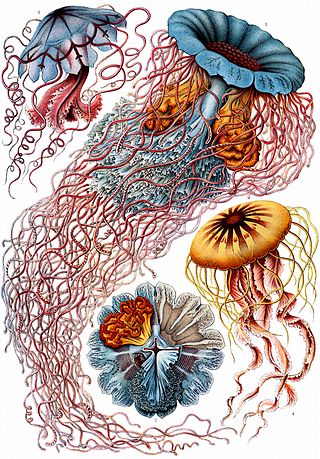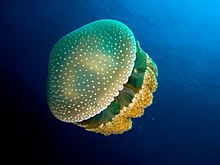
Cnidaria is a phylum under kingdom Animalia containing over 11,000 species of aquatic animals found both in freshwater and marine environments, including jellyfish, hydroids, sea anemone, corals and some of the smallest marine parasites. Their distinguishing feature is the cnidocytes, specialized cells with ejectable flagella used mainly for envenomation and capturing prey. Their bodies consist of mesoglea, a non-living jelly-like substance, sandwiched between two layers of epithelium that are mostly one cell thick.

Jellyfish and sea jellies are the common names given to the medusa-phase of certain gelatinous members of the subphylum Medusozoa, which is a major part of the phylum Cnidaria.

The Scyphozoa are an exclusively marine class of the phylum Cnidaria, referred to as the true jellyfish.

Rhizostomae or Rhizostomeae is an order of jellyfish. Species of this order have neither tentacles nor other structures at the bell's edges. Instead, they have eight highly branched oral arms, along which there are suctorial minimouth orifices. These oral arms become fused as they approach the central part of the jellyfish. The mouth of the animal is also subdivided into minute pores that are linked to coelenteron.

Jellyfish Lake is a marine lake located on Eil Malk island in Palau. Eil Malk is part of the Rock Islands, a group of small, rocky, mostly uninhabited islands in Palau's Southern Lagoon, between Koror and Peleliu. There are about 70 other marine lakes located throughout the Rock Islands. Millions of golden jellyfish migrate horizontally across the lake daily.

Discomedusae is a subclass of jellyfish in the class Scyphozoa. It is the sister taxon of Coronamedusae. Discomedusae contains about 155 named species and there are likely to be many more as yet undescribed. Jellyfish in this subclass are much more likely to have swarming events or form blooms than those in Coronamedusae. Discomedusae consists of two orders, Rhizostomae and Semaeostomeae.

Phyllorhiza punctata is a species of jellyfish, also known as the floating bell, Australian spotted jellyfish, brown jellyfish or the white-spotted jellyfish. It is native to the western Pacific from Australia to Japan, but has been introduced widely elsewhere. It feeds primarily on zooplankton. P. punctata generally can reach up to 50 centimetres (20 in) in bell diameter, but in October 2007, one 72 cm (28 in) wide, perhaps the largest ever recorded, was found on Sunset Beach, North Carolina.

Phyllorhiza is a genus of jellyfish in the family Mastigiidae.

Cotylorhiza is a genus of true jellyfish from the family Cepheidae. The genus is found in the central-east Atlantic, Mediterranean, and western Indian Ocean.

Stomolophus is a genus of true jellyfish from the West Atlantic and Pacific. It is the only genus in the monotypic family Stomolophidae. Formerly, Nomura's jellyfish was also included in this genus, but has now been reclassified to the family Rhizostomatidae.

The spotted jelly, lagoon jelly, golden medusa, or Papuan jellyfish, is a species of jellyfish from the Indo-Pacific oceans. Like corals, sea anemones, and other sea jellies, it belongs to the phylum Cnidaria. Mastigias papua is one of the numerous marine animals living in symbiosis with zooxanthellae, a photosynthetic alga.

Mastigias is a genus of true jellyfish in the family Mastigiidae. It contains seven described species. Members of this genus are found widely in coastal regions of the Indo-Pacific, including saline lakes of Palau, but there are also records from the West Atlantic at Florida and Puerto Rico. The West Atlantic records are most likely the result of accidental introductions by humans.
Clear Lake is a marine lake located on Eil Malk island in Palau. Eil Malk is part of the Rock Islands, a group of small, rocky, mostly uninhabited islands in Palau's Southern Lagoon, between Koror and Peleliu. There are about 70 other marine lakes located throughout the Rock Islands. Clear Lake is notable for endemic subspecies of golden jellyfish and is one of five marine lakes in Palau used for several scientific researches in evolutionary biology, the other lakes being Jellyfish Lake, Goby Lake, Uet era Ngermeuangel, Uet era Ongael.
Goby Lake is a marine lake located on Koror island in Palau. There are about 70 other marine lakes located throughout the Rock Islands and Koror. Goby Lake is notable for endemic subspecies of golden jellyfish and is one of five marine lakes in Palau used for several scientific researches in evolutionary biology the other lakes being Jellyfish Lake, Clear Lake (Palau), Uet era Ngermeuangel, Uet era Ongael.
Uet era Ngermeuangel is a marine lake located on Koror island in Palau. There are about 70 other marine lakes located throughout the Rock Islands and Koror. Uet era Ngermeuangel is notable for endemic subspecies of golden jellyfish and is one of five marine lakes in Palau used for several scientific researches in evolutionary biology the other lakes being Jellyfish Lake, Clear Lake (Palau), Goby Lake, Uet era Ongael.
Uet era Ongael is a marine lake located on Ongael Island, Koror, in Palau. There are about 70 other marine lakes located throughout the Rock Islands and Koror. Uet era Ongael is notable for endemic subspecies of golden jellyfish and is one of five marine lakes in Palau used for several scientific researches in evolutionary biology, the other lakes being Jellyfish Lake, Clear Lake, Uet era Ngermeuangel and Goby Lake.
Mastigias ocellatus, the golden medusa, is a species of jellyfish in the family Mastigiidae. It is native to the southern Pacific Ocean.

Cassiopea ornata are one of many Cnidarian species called the upside-down jellyfish. This pelagic jellyfish primarily lives in tropical waters, off the coast of Australia in shallow lagoons and around mangrove trees. The name "upside-down jellyfish" comes from the fact that it appears to be upside-down in its natural state—resting on its bell. Its bell is a golden/brown color and the tentacles vary with different shades of yellow. While the sighting of this particular species is rare, it is usually mistaken for vegetation like the other species in genus Cassiopea.

The golden jellyfish is a subspecies of spotted jellyfish that inhabits Jellyfish Lake on Eil Malk island in Palau in the western Pacific Ocean. Like the nominate subspecies, it derives part of its nutrition from symbiotic algae (Zooxanthellae) that live in their tissues and part of their nutrition from captured zooplankton.
Mastigias andersoni is a species of true jellyfish in the family Mastigiidae. It has been found in waters off the coast of Australia.













